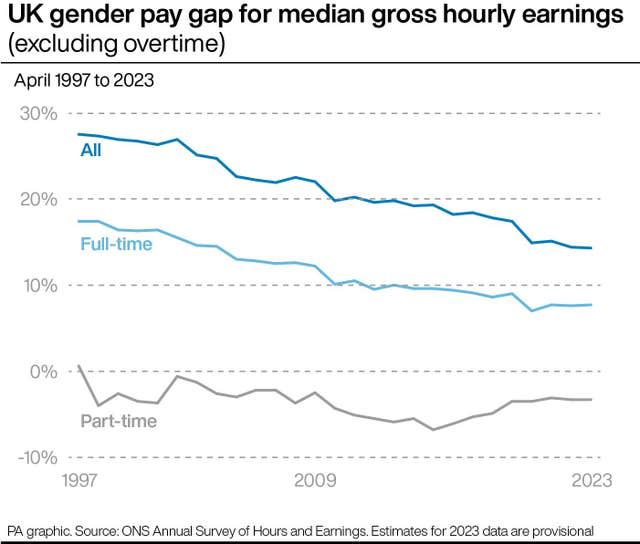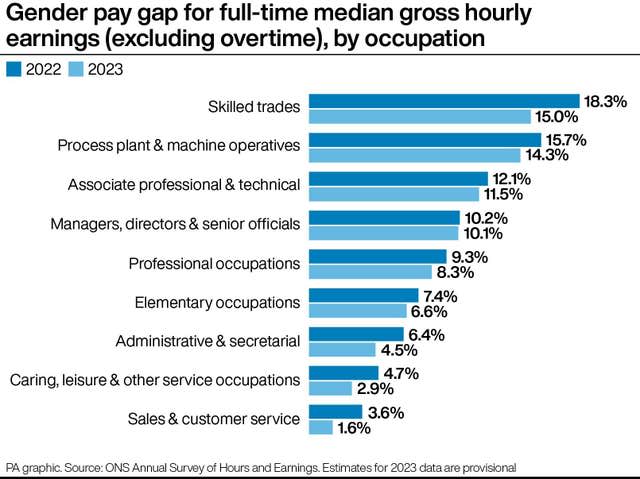Little change in gender pay gap in past year, study suggests
The gender pay gap for full-time workers has barely changed over the past year, new figures suggest.
The gap among full-time employees increased to 7.7% this year, up from 7.6% in 2022, said the Office for National Statistics (ONS).
It is still below the gap of 9% before the coronavirus pandemic in 2019.
Among all employees, the gender pay gap fell to 14.3% this year, from 14.4% in 2022, and is still below the figure of 17.4% seen in 2019.

The ONS reported that the gender pay gap has been declining slowly over time, falling by around a quarter over the last decade among full-time employees.
There remains a big difference in the gender pay gap between employees aged 40 and over and those under 40.
The gender pay gap among full-time employees is higher in every English region than in Wales, Scotland or Northern Ireland.
Dr Zara Nanu, of XpertHR, said not enough is being done to tackle the gender pay gap, adding: “We’ve put a man on the Moon, created self-driving cars, and are now seeing the impacts AI could bring to all our lives. We have the technological solutions to reduce the gap, and more often than not an idea of how to tackle the gap, but it’s down to companies to use these innovations and take action on the results the data finds.”
The ONS also reported that median weekly earnings for full-time employees was £682 in April 2023, a 6.2% increase over the £642 in April last year.
It was described as the highest growth since comparable records began in 1997.
But median weekly earnings for full-time employees fell by 1.5% on the year in real terms, adjusted for inflation.

Median weekly earnings for full-time employees saw growth across all major occupational groups, particularly for lower-paying occupations, with caring, leisure and other service occupations up 9.4% and sales and customer service occupations up 9.2% compared with the previous year, said the ONS.
ONS head of earnings statistics Nicola White said: “Our detailed annual survey shows that, in the year to April 2023, employees saw their pay growing at its fastest in cash terms since comparable records began, but, once inflation is taken into account, people’s pay fell again in real terms.
“Thanks partly to increases in the National Minimum Wage, lower-paid groups saw faster earnings growth over the year than those higher up the pay scale.
“The full-time gender pay gap was very little changed on the year, but has fallen by about a quarter over the last decade and remains smaller than it was before the coronavirus pandemic.”
TUC general secretary Paul Nowak said: “Our economy isn’t working for women. At this rate it will take decades to close the gender pay gap.
“We need bolder action now. Companies must be legally required to explain how they’ll close their gender pay gaps – and should face fines if they don’t comply with the law.
“We must fix Britain’s broken childcare and social care systems, or women will continue to lose out as they bear the brunt of caring responsibilities. Fixing care is critical to raising women’s earnings.
“We desperately need more flexible, affordable and accessible childcare for all families, that works around shifts, weekend work and irregular working patterns.”
Shadow women and equalities secretary Anneliese Dodds said: “Today’s figures lay bare the Conservatives’ complete and utter failure to deliver for working women.
“We have seen 13 years of low growth and stagnant pay. As usual, it’s women footing the bill for Conservative failure.
“Labour has a clear plan to get our economy growing. We will put women at the heart of this growth through our New Deal for Working People, with policies from flexible working to childcare and menopause support, which will support women at work to flourish and build their careers.”


